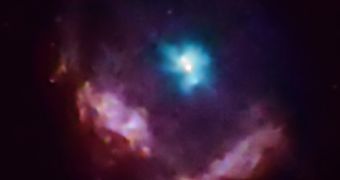X-ray images of the Kes75 supernova remnant shows it to house what seems to be a rapidly spinning neutron star, commonly known as a pulsar, which could have been created in the outcome of the supernova explosion. Lying at a distance of about 20,000 light years away from Earth, Kes75's pulsar located close to the center of the supernova remnant experiences rapid rotation, complemented by the creation of a powerful magnetic field generated by the pulsar, which, in turn, accelerates matter and antimatter particle to relativistic speeds.
Elementary particles accelerated into powerful magnetic fields tend to rush through the void of space at the speed of light, but will never reach speeds higher than 99 percent the speed of light. However, energy pumped into them by the magnetic fields needs to be evacuated through some kind of process, thus the particles emit X-ray light. In the image provided by the Chandra X-ray Space Observatory, low energy X-rays are represented in the color red, while strong X-ray emissions are colored in blue. The system created by the pulsar through magnetizing the matter debris of the supernova remnant in its vicinity is usually referred to as the pulsar wind nebular, and can be observed in the X-ray image as the bright blue feature surrounding the central star.
Although pulsars are known to present extremely powerful magnetic fields, that of Kes75 seems to be much more powerful than that of most known pulsars, but still not enough to be cataloged as a magnetar, objects which produce probably the most powerful magnetic fields in the known universe. Now, NASA researchers are trying to determine what is the relation between pulsars and magnetars.
With the help of the Rossi X-ray Timing Explorer, or RXTE, Goddard Space Flight Center scientist Fotis Gavriil discovered that the X-ray emissions from Kes 75 are so powerful that they match exactly that or radiation emissions from magnetars. These particular emissions, however, originate at the surface of the neutron star, and are probably determined mostly by violent changes in the structure of the magnetic field accompanied by proportional variations in the spin rate of the star. Six years before, the Chandra X-ray Space Observatory studied the same pulsar but in a much calmer period of time, when it was not so bright in the X-ray spectrum, suggesting that Kes75 is somehow quickly turning into a magnetar.

 14 DAY TRIAL //
14 DAY TRIAL //